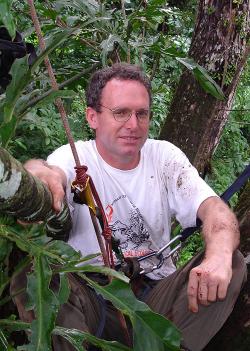
Professor
Email: wings@berkeley.edu
Phone: (510) 642-1555
Lab Webpage: http://berkeleyflightlab.org/
Research Description
Our group works on the biomechanics, energetics, and evolution of animal flight. Flight performance is investigated in the laboratory using high-speed three-dimensional videography, metabolic measurements, particle-image velocimetry, and physically-variable gas mixtures. Two current goals are to describe hummingbird kinematic and metabolic responses to variable levels of air turbulence within a wind tunnel, and to evaluate the functional correlates of wing reduction among a diversity of stick insect species. Laboratory studies of flight biomechanics are complemented by fieldwork around the planet, including the ecophysiology of butterfly migrations in Panama, gliding in Southeast Asian flying lizards, hummingbird flight metabolism across elevational gradients in Peru, high-altitude adaptations in Sichuan bumblebees, and controlled aerial behavior in wingless hexapods of the Neotropical forest canopy. Research students are encouraged to ask idiosyncratic biomechanical and ecophysiological questions to which a diversity of technological and phylogenetic approaches available in the lab may be applied.
Selected Publications
Badger, M., McClain, K., Smiley, A., Ye, J. and R. Dudley. (2023). Sideways maneuvers enable narrow aperture negotiation by free-flying hummingbirds. Journal of Experimental Biology 226:jeb245643.
Choi, J., Lee, L., Maro, A., Corl, A., McGuire, J.A., Bowie, R. and R. Dudley. (2023). Hummingbird consumption of low-concentration ethanol in artificial nectar. Royal Society Open Science 10:230306.
Sathe, E.A., Chronister, N. and R. Dudley. (2023). Incipient wing flapping enhances aerial performance of a robotic paravian model. Bioinspiration & Biomimetics 18:046017.
Zeng, Y., Park, S., Gonzales, C., Yom, S. Rahim, F. and R. Dudley. (2023). Beyond winglets: evolution of flight-related morphology in stick insects (Phasmatodea). Biological Journal of the Linnean Society 140:176-195.
Brown, C., Sathe, E.A., Dudley, R. and S.M. Deban. (2022). Gliding and parachuting by arboreal salamanders. Current Biology 32:R453-454.
Campbell, C., Maro, A., Weaver, V. and R. Dudley. (2022). Dietary ethanol ingestion by free- ranging spider monkeys (Ateles geoffroyi). Royal Society Open Science 9:211729. (6 pp.)
Maro, A. and R. Dudley. (2022). Non-random distribution of ungulate salt licks relative to distance from North American oceanic margins. Journal of Biogeography 49:254-260.
Dudley, R. and A. Maro. (2021). Human evolution and dietary ethanol. Nutrients 13:2419
Zeng, Y., Chang, S.W., Williams, J.Y., Nguyen, L.Y.-N., Tang, J., Naing, G., Kazi, C. and R. Dudley. (2020). Canopy parkour: movement ecology of post-hatch dispersal in a gliding nymphal stick insect (Extatosoma tiaratum). Journal of Experimental Biology 223:226266.
Badger, M.A., Wang, H. and R. Dudley. (2019). Avoiding topsy-turvy: how Anna’s Hummingbirds (Calypte anna) fly through upward gusts. Journal of Experimental Biology 222:176263.
Rico-Guevara, A., Rubega, M.A., Hurme, K.J. and R. Dudley. (2019). Shifting paradigms in the mechanics of nectar extraction and hummingbird bill morphology. Integrative Organismal Biology 10.1093/iob/oby006
Ortega-Jimenez, V., Badger, M., Wang, H. and R. Dudley. (2017). Into rude air: hummingbird flight performance in variable aerial environments. Philosophical Transactions of the Royal Society of London B 371:20150387.
Yanoviak, S.P., Munk, Y. and R. Dudley. (2015). Arachnid aloft: directed aerial descent in a Neotropical canopy spider. Journal of the Royal Society Interface 12:20150534 (5 pp.)
Dillon, M.E. and R. Dudley. (2014). Surpassing Mt. Everest: extreme flight performance of alpine bumble-bees. Biology Letters doi:10.1098/rsbl.2013.0922.
Dudley, R. (2014). The Drunken Monkey: Why We Drink and Abuse Alcohol. Berkeley: University of California Press. 154 pp.
Dudley, R. (2000). The Biomechanics of Insect Flight: Form, Function, Evolution. Princeton: Princeton University Press. 476 pp.